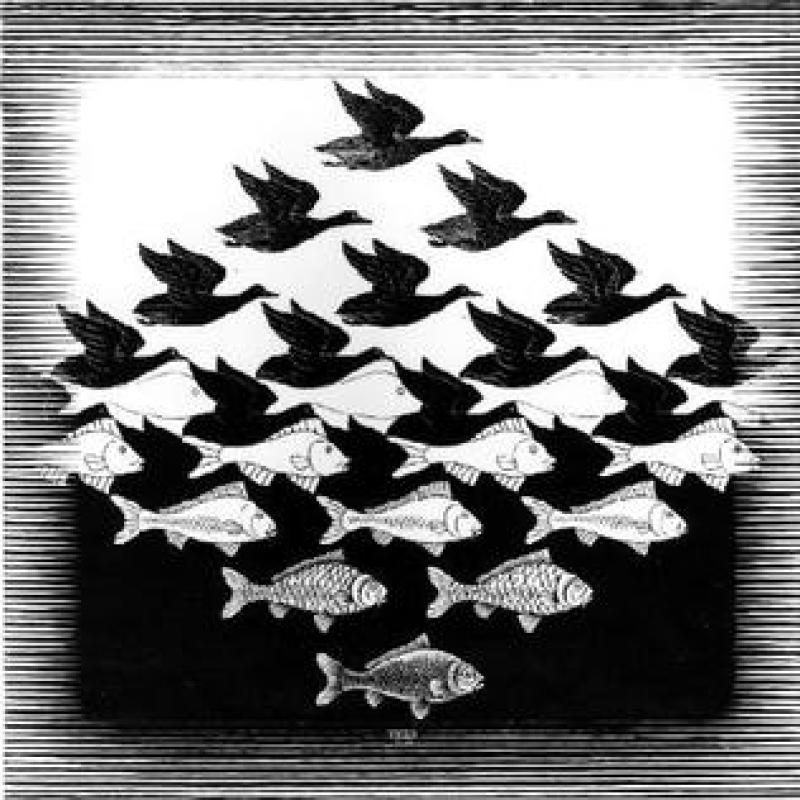The Mysterious Illusions of M.C.Escher
The Mysterious Illusions of M.C.Escher
The brilliant graphic artist M.C.Escher has created incredible images but I intend to write only about a few of them. The first are his optical illusions. This first graphic indicates a waterfall, and what appears to be a downward flow of the water...until it reaches the top of and flows down the waterfall.
The second of what I could call a series shows people appearing to be marching up and down a staircase at the top of a building, but they are actually walking in a circle.
The graphic below is not an illusion but is illusory in that it flows from image to image. It it is entitled "Metamorphosis", an apt name for it. It is actually one long drawing from end to end, but for the purpose of space is shown here as 4 panels. This one proved to me the genius of Escher, whose attention to detail was so exact that the chess set which is shown 2 changes from the end is set up to require two moves to checkmate, i.e. two moves to the end. The black queen must just have landed in the square between the white king and white rook (castle). The first move that is required is for the white rook to take off the black queen as no other possible move can rescue the white king from being in check. The white king could not have taken off the black queen because the queen is protected by a black bishop up at the top left of the board. The second move then has to be the black knight (horse) moving in next to the white pawn to target both the white queen and the white king, putting the king into checkmate because the king is surrounded by white pieces and cannot move away, nor can the knight be taken off or its path blocked. That makes it two moves to the end, which is exactly the same as the graphic - two changes to the end, which is, as you can see, just like the beginning. "Just like the beginning", meaning that it is similar to the sign for infinity in that it never ends but repeats eternally.
Many years ago I was given a "coffee table" book of Escher's work and story, and it has been a treasure - one of the few items I brought with me to China. I recall that when I got the book I set up my chess board with the pieces as in the graphic and played it out to checkmate - two moves - and marvelled at Escher's attention to detail.







Not photographs, but we did change the group to include other artistic works.
I've long been a fan of Escher's work.
Brilliant, Buzz! I was not familiar with Escher and now I am - thank you!
Few know that much of Escher's works are tessellation patterns most people have never heard or read the word.
I originally posted this article about four years ago on the Creative Arts group, but today Escher's name came up in a discussion on the latest Creative Arts group Thursday/Friday photo posting article, so I thought I would resurrect it and promote it to the Front Page so all could see.
One of my children went to a recent Escher exhibit in Brooklyn, NY. If anyone is interested and is in the area, the exhibit has been extended until March 31, 2019.
Ties...socks...print tees...got 'em all!
He Bosche are my obsession.
I went to an Escher exhibit many years ago. While there a patron had an epileptic seizure. Had something to do with excessive neural activity.
Well, some of his works are downright mentally challenging. Not everything he did was mysterious. I'm going to post more of his works and some of his quotes from the Escher book I have.
The article promotion photo (at the top of this article) is called "Sky and Water" - From the top the birds are surrounded by air, which is associated with flying, while metamorphosing downwards the air between the birds takes on the images of fish and further down the birds become the water between the fish - water being associated with swimming.
Under the title of the article, the image is called "Waterfall", one of what is known as "Impossible Buildings", as is the next image. Perhaps "excessive neural activity" (as mentioned by Pat above) is required to figure out why since both towers, each of equal height, in the "Waterfall" image differ as they do - the one standing on a higher level is not as high as the one standing on the "lower" level, besides the fact of the water appearing to flow upwards.
The next image is called Ascending and Descending. In the image you will see two individuals who refuse to take part in the useless activity of climbing and descending a never-ending staircase.
The final image is Metamorphosis, which I comment about in the article above.
The text in my book was written by Escher himslelf, who was alive in 1960 when it was published. His introduction to it starts with these words:
He then goes on to explain the images.
I wrote a lot about my Escher book. This is the one I have:
In his book, Escher explains the advances in his technique, which "metamorphose", i.e. change throughout his career. This comment will go through the consecutive stages of his style. Escher's early works were not mysterious. This one is called Castrovalva, a mountainous area in the Abruzzi region of Italy.
His next step was Development of Form and Contrast - the top photo, Sky and Water, falls into that category, as does this one of the favourites from my book, "Day and Night". (All of the images are ones from my book.)
Next step, is what he calls Infinity of Number . He did create some colour images - this one is Circle Limit III.
Following that are "Story Pictures" , which indicate a transition from flat to spatial. The one with the chess board in the posted article, "Metamorphosis" is one of those, and this one is entitled "Reptiles".
Irregular Filling of Plane Surfaces is illustrated by Mosaic II:
Unlimited Spaces has a 3-dimensional quality. This one is called "Depth".
Spatial Rings and Spirals . Here he really gets into the Mobius and other strips, and there are some great examples of that. I like this one, called Bond of Union. It has been interpreted as the meeting of minds.
TO BE CONTINUED
CONTINUATION OF ESCHER'S STYLES
Reflections in Water. Three Worlds. Those are the reflection of the trees which are above the water, their leaves floating on the surface, and the fish below the surface.
Sphere Reflections. Hand with Reflecting Globe. That is actually an image of Escher himself. This is one of the more commonly known Escher images.
INVERSION . Concave and Convex. There is an exterior view of the house on the left, an interior view of the house on the right, and both interior and exterior views of the house in the middle.
POLYHEDRONS . Tetrahedral Planetoid. This planetoid is surrounded by an atmosphere enabling humans to live in it.
RELATIVITIES. Another World. Different perspectives are visible through the windows.
CONFLICT BETWEEN THE FLAT AND THE SPATIAL. Drawing Hands. This is another of my favourites.
IMPOSSIBLE BUILDINGS. The two buildings in the original article above fall within this category. This one is called Belvedere. As you can see, the pillars between the floors are impossible, and that concept is reflected in the object in the hands of the boy sitting on the bench. Included here is a larger image of the boy holding the object, and a model of the object itself.
Hopefully, now having seen his graphic style up until 1960, when my book was published (he lived another 12 years) your mind is not entirely scrambled.
Obviously I should be spending my time on my Movies group.
I enjoyed it as I do all of your pictures
Thanks, charger. You're one of the most supportive members of NT.
That is really amazing art work Buzz.
I think he was unbelievably creative, and a pioneer whom others have tried to imitate.
I agree, his works are fascinating to say the least.